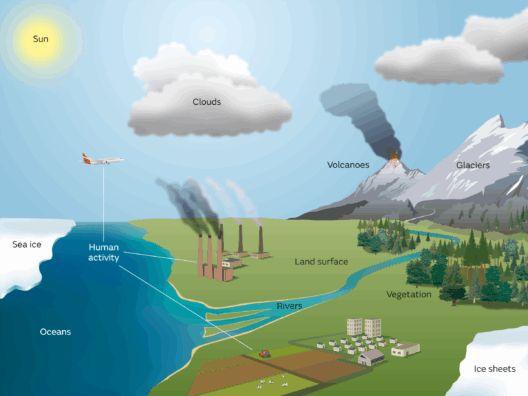In the contemporary discourse surrounding environmental issues, two terms frequently emerge: global warming and climate change. These terms are often misused interchangeably, leading to confusion that belies the complexity of the phenomena they describe. While both pertain to the Earth’s climate system and are interrelated, they represent distinct concepts. Understanding these differences is crucial for both scientific discourse and public comprehension of the challenges facing our planet.
Global warming refers to the observed increase in Earth’s average surface temperature due primarily to human emissions of greenhouse gases (GHGs) such as carbon dioxide, methane, and nitrous oxide. Since the late 19th century, scientific studies demonstrate a marked rise in temperature, a phenomenon inexplicable without the influence of anthropogenic activities. This warming is largely attributed to the burning of fossil fuels, deforestation, and industrial processes that release GHGs into the atmosphere. The ramifications of global warming are profound, affecting weather patterns, ice sheet dynamics, and sea levels. As the thermal blanket of GHGs thickens, it traps heat that would otherwise escape into space, leading to a gentle yet inexorable rise in overall temperatures.
On the other hand, climate change encompasses a broader spectrum of alterations in the Earth’s climate system, which includes shifts in temperature, precipitation patterns, and extreme weather events. While global warming is a major contributor to climate change, the latter also includes natural processes such as volcanic eruptions, solar variations, and oceanic circulations. Furthermore, climate change embodies the long-term patterns and trends in climate variability—a canvas painted not just by anthropogenic influences but also by natural fluxes that have occurred over geological timeframes. It reflects not merely a statistical increase in temperatures but a complex interaction between atmospheric and terrestrial systems over decades and centuries.
Observational studies indicate that our current climate crisis arises from an unnaturally rapid acceleration of these changes, driven predominantly by human activity. The Intergovernmental Panel on Climate Change (IPCC) underscores the point that the rapidity of contemporary climate change is unprecedented in the modern era, relegating natural variances to a secondary role in this epoch of anthropogenic transformation. Temperature averages are shifting dramatically, leading to phenomena such as heatwaves, flooding, droughts, and hurricanes—all manifestations of a climate system under duress.
Furthermore, the distinction between global warming and climate change invites social scrutiny. The term “climate change” may resonate more effectively with certain audiences when discussing the cause and effect of anthropogenic impacts on the environment, especially regarding development strategies or policy changes. Laying the groundwork for public policy to combat climate change necessitates a more comprehensive understanding of its contributors and consequences beyond the simplified notion of warming alone. This broader perspective allows discussions to encompass various facets, such as economic implications, energy transition strategies, and adaptation and mitigation efforts.
Curiously, the divergence in public perception between these two terms also highlights a fascinating psychological dynamic. Typically, “global warming” can invoke imagery of a distant future filled with dire consequences, insinuating a sense of doom. In contrast, “climate change” encompasses a wide range of phenomena that many perceive as already unfolding in their lives. This subtle discrepancy may drive people to recognize climate change as an immediate concern, prompting calls for action while potentially sidelining the specific mechanisms driving those changes.
Education plays a pivotal role in unraveling the complexities associated with global warming and climate change. It is critical to elucidate not only the scientific principles underlying these terms but also the socio-economic factors at play. By fostering a nuanced understanding of environmental science, communities can better engage with related issues—from renewable energy adoption to sustainable land use practices. In this regard, fostering environmental literacy becomes an essential vehicle for driving grassroots movements aimed at mitigating climate impacts.
Indubitably, the urgency of addressing these matters grows more pressing by the day. The escalating frequency and intensity of natural disasters are potent reminders that the ramifications of global warming and climate change are no longer remote or theoretical. They are here, now, compelling societies globally to take actionable steps towards resilience and sustainability. This reality beckons individuals, communities, and nations to unite in an effort to combat escalating threats through informed policies and dignified discourse.
In conclusion, while global warming identifies a specific trend of temperature rise resultant from anthropogenic climate forces, climate change is a broad, encompassing term indicating a range of alterations in weather and environmental patterns. Understanding the nuances between these concepts is vital for effective communication, education, and policy-making in the quest for a sustainable future. The interplay between humanity’s actions and the Earth’s climatic responses underlines the significant responsibility we bear in shaping outcomes. Only through collective understanding and concerted effort can we navigate the turbulent waters of climate events and work toward safeguarding the planet for future generations.





